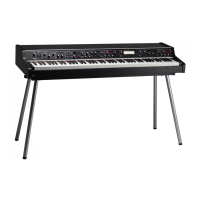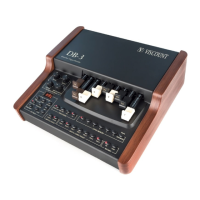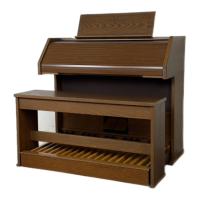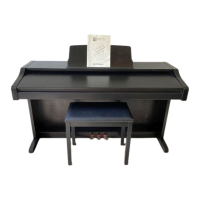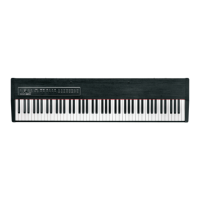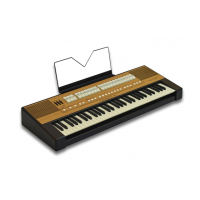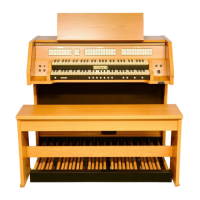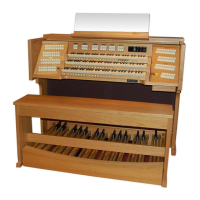Do you have a question about the Viscount Legend SOUL 261 and is the answer not in the manual?
Comprehensive safety guidelines and warnings for operating the instrument safely.
Guidelines for proper handling, cleaning, and upkeep of the instrument.
Explanation of the manual's content, disclaimers, and usage conventions.
Overview of the instrument's key features, technology, and innovations.
Description of primary controls on the upper section of the instrument.
Explanation on how to use the drawbars for sound shaping.
Configuration of percussion effects and pedal sustain.
Details on the display, data entry dial, and navigation buttons.
Controls for organ model selection, transposition, and pitch adjustment.
Operation of the multi-effect section and rotary/amp simulator.
Configuration of the master equalizer and pedal assignments.
Controls for rotary speed simulation and headphone connection.
Details on all audio jacks and pedal input connectors.
Ports for MIDI devices, USB flash drives, and power connection.
Linking the instrument to amplifiers, mixers, and external effects.
Interfacing with external sound generators, keyboards, and computers.
Instructions for connecting and utilizing various foot pedals.
Steps for powering on/off and initial instrument setup.
Overview of sound engine, organ models, and drawbar functionality.
Details on drawbars, percussion, vibrato/chorus, reverb, and rotary/amp effects.
How to view and select stored programs on the instrument.
Procedure for saving custom sound configurations as programs.
How to access and move through the instrument's edit menu sections.
Adjusting audio routing, vibrato/chorus, and multi-effects settings.
Settings for drawbar presets, percussion, and manual modes.
Parameters related to pedalboard functions and key touch simulation.
Instrument tuning, transposition settings, and master equalizer configuration.
Configuration of audio outputs, inputs, and pedal assignments.
MIDI settings and how programs recall panel states.
Settings for display, USB port, memory protection, and auto power off.
Procedures for backing up, restoring, and updating the instrument's system.
Explanations of error codes and solutions to common operational problems.
Basics of MIDI communication protocol and channel usage.
Details on transmitted/received MIDI messages and the implementation chart.
Comprehensive safety guidelines and warnings for operating the instrument safely.
Guidelines for proper handling, cleaning, and upkeep of the instrument.
Explanation of the manual's content, disclaimers, and usage conventions.
Overview of the instrument's key features, technology, and innovations.
Description of primary controls on the upper section of the instrument.
Explanation on how to use the drawbars for sound shaping.
Configuration of percussion effects and pedal sustain.
Details on the display, data entry dial, and navigation buttons.
Controls for organ model selection, transposition, and pitch adjustment.
Operation of the multi-effect section and rotary/amp simulator.
Configuration of the master equalizer and pedal assignments.
Controls for rotary speed simulation and headphone connection.
Details on all audio jacks and pedal input connectors.
Ports for MIDI devices, USB flash drives, and power connection.
Linking the instrument to amplifiers, mixers, and external effects.
Interfacing with external sound generators, keyboards, and computers.
Instructions for connecting and utilizing various foot pedals.
Steps for powering on/off and initial instrument setup.
Overview of sound engine, organ models, and drawbar functionality.
Details on drawbars, percussion, vibrato/chorus, reverb, and rotary/amp effects.
How to view and select stored programs on the instrument.
Procedure for saving custom sound configurations as programs.
How to access and move through the instrument's edit menu sections.
Adjusting audio routing, vibrato/chorus, and multi-effects settings.
Settings for drawbar presets, percussion, and manual modes.
Parameters related to pedalboard functions and key touch simulation.
Instrument tuning, transposition settings, and master equalizer configuration.
Configuration of audio outputs, inputs, and pedal assignments.
MIDI settings and how programs recall panel states.
Settings for display, USB port, memory protection, and auto power off.
Procedures for backing up, restoring, and updating the instrument's system.
Explanations of error codes and solutions to common operational problems.
Basics of MIDI communication protocol and channel usage.
Details on transmitted/received MIDI messages and the implementation chart.
| Number of Keys | 61 |
|---|---|
| Type | Digital Organ |
| Keyboard | Waterfall |
| Sound Generation | Physical Modeling |
| Presets | 128 |
| Effects | Reverb, Chorus |
| Connectivity | MIDI, USB, Audio Out, Headphone Jack |
| Power Supply | 100-240V AC |

